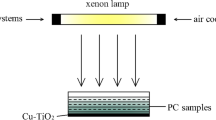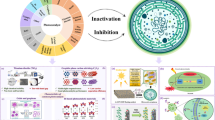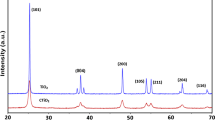Abstract
In this study, the validity of TiO2-based photocatalysts anti-algal effects was examined with Chlorella vulgaris. Cu-modified TiO2 (without N dopants) showed clear anti-algal effect under white LED light. N-doped TiO2 (both with and without Cu modification) and Cu-modified TiO2 (without N dopants) showed clear anti-algal effects when UV light was used together with white LED light. S-doped TiO2 had no anti-algal effects and even promoted the growth of algae. The degree of the anti-algal effect differed depending on the dopants, surface modifications, and irradiation light. Photocatalysts create several active spices during their photocatalytic processes. Of these, the effects of superoxide radical (O ·−2 ) and hydrogen peroxide (H2O2) on algae growth were examined. Photocatalysts with high anti-algal effect produced hydrogen peroxides effectively, while there was no correlation between productivity of superoxide radical and anti-algal effects. Thus, the ability to produce hydrogen peroxide is a plausible factor for determining the efficiency of the anti-algal effect of a photocatalysts.
Graphical Abstract







Similar content being viewed by others
References
Asao T, Kitazawa H, Ban T, Pramanik MHR, Matsui Y, Hosoki T (2004) Search of autotoxic substances in some leaf vegetables. J Jpn Soc Hortic Sci 73:247–249. doi:10.2503/jjshs.73.247
Fujishima A, Honda K (1972) Electrochemical photolysis of water at a semiconductor electrode. Nature 238:37–38. doi:10.1038/238037a0
Fujishima A, Zhang X, Tryk DA (2008) TiO2 photocatalysis and related surface phenomena. Surf Sci Rep 63:515–582. doi:10.1016/j.surfrep.2008.10.001
Miyama Y, Sunada K, Fujikawa S, Hashimoto K (2009) Photocatalytic treatment of waste nutrient solution from soil-less cultivation of tomatoes planted in rice hull substrate. Plant Soil 318:275–283. doi:10.1007/s11104-008-9837-4
Tajima M, Fukuda K, Komatsubara S (2014) Japan patent, P5419029 (in Japanese)
Peller JR, Whitman RL, Griffith S, Harris P, Peller C, Scalzitti J (2007) TiO2 as a photocatalyst for control of the aquatic invasive alga, Clodophora, under natural and artificial light. J Photochem Photobiol A Chem 186:212–217. doi:10.1016/j.photochem.2006.08.009
Shin H-J, Kim B-H, Seo HS, Kim CS, Kook J-K, Lim G-T, Cho D-L, Kim D, Ohk SH, Ko Y-M (2009) Degradation of Cochlodinium polykrikoides using photocatalytic reactor with TiO2-coated alumina. Biotechnol Bioprocess Eng 14:531–535. doi:10.1007/s12257-009-0048-5
Ochiai T, Fukuda T, Nakata K, Murakami T, Tryk DA, Koide Y, Fujishima A (2010) Photocatalytic inactivation and removal of algae with TiO2-coated materials. J Appl Electrochem 40:1737–1742. doi:10.1007/s10800-010-0133-7
Metzler DM, Li M, Erdem A, Huang CP (2011) Responses of algae to photocatalytic nano-TiO2 particles with an emphasis on the effect of particle size. Chem Eng J 170:538–546. doi:10.1016/j.cej.2011.02.002
Gu N, Gao J, Wang K, Yang X, Dong W (2015) ZnO-montmorillonite as photocatalyst and flocculant for inhibition of cyanobacterial bloom. Water Air Soil Pollut 226:136. doi:10.1007/s11270-015-2407-5
Pelaez M, Nolan NT, Pillai SC, Seery MK, Falaras P, Kontos AG, Dunlop PSM, Hamilton JWJ, Byrne JA, O’Shea K, Entezari MH, Dionysiou DD (2012) A review on the visible light active titanium dioxide photocatalysts for environmental applications. Appl Catal B Environ 125:331–349. doi:10.1016/j.apcatb.2012.05.036
Details of this microbial culture is described in the following web site. http://mcc.nies.go.jp/02medium-e.html#c
Ukeda H (2004) Detection of superoxide anion with WST-1 and its application. Dojin News 112:1–8 (in Japanese)
Oritani T, Fukuhara N, Okajima T, Kitamura F, Ohsaka T (2004) Electrochemical and spectroscopic studies on electron-transfer reaction between novel water-soluble tetrazolium salts and a superoxide ion. Inorg Chim Acta 357:436–442. doi:10.1016/j.ica.2003.05.007
Imase M, Ohko Y, Takeuchi M, Hanada S (2013) Estimating the viability of Chlorella exposed to oxidative stresses based around photocatalysis. Int Biodeterior Biodegrad 78:1–6. doi:10.1016/j.ibiod.2012.12.006
Hirakawa T, Nosaka Y (2008) Selective production of superoxide ions and hydrogen peroxide over nitrogen- and sulfur-doped TiO2 photocatalysts with visible light in aqueous suspension systems. J Phys Chem C 112:15818–15823. doi:10.1021/jp8055015
Hirakawa T, Nosaka Y (2002) Properties of O ·−2 and OH· formed in TiO2 aqueous suspensions by photocatalytic reaction and the influence of H2O2 and some ions. Langmuir 18:3247–3254. doi:10.1021/la015685a
Liu M, Qiu X, Miyauchi M, Hashimoto K (2011) Cu(II) oxide amorphous nanoclusters grafted Ti3+ self-doped TiO2: an efficient visible light photocatalyst. Chem Mater 23:5282–5286. doi:10.1021/cm203025b
Yamanaka K, Morikawa T (2012) Charge-carrier dynamics in nitrogen-doped TiO2 powder studied by femtosecond time-resolved diffuse reflectance spectroscopy. J Phys Chem C 116:1286–1292. doi:10.1021/jp209210u
Morikawa T, Irokawa Y, Ohwaki T (2006) Enhanced photocatalytic activity of TiO2−xNx loaded with copper ions under visible light irradiation. Appl Catal A 314:123–127. doi:10.1016/j.apcata.2006.08.011
Yamanaka K, Ohwaki T, Morikawa T (2013) Charge-carrier dynamics in Cu- or Fe-loaded nitrogen-doped TiO2 powder studied by femtosecond diffuse reflectance spectroscopy. J Phys Chem C 117:16448–16456. doi:10.1021/jp404431z
Mallick N (2004) Copper-induced oxidative stress in the chlorophycean microalga Chlorella vulgaris: response of the antioxidant system. J Plant Physiol 161:591–597. doi:10.1078/0176-1617-01230
Wang W, Vinocur B, Altman A (2003) Plant responses to drought, salinity and extreme temperatures: towards genetic engineering for stress tolerance. Planta 218:1–14. doi:10.1007/s00425-003-1105-5
Acknowledgements
This work was partially supported by the Strategic International Collaborative Research Program (SICORP) of the Japan Science and Technology Agency (JST).
Author information
Authors and Affiliations
Corresponding author
Additional information
Norihiro Suzuki and Takuo Sanada have contributed equally to this work.
Electronic supplementary material
Below is the link to the electronic supplementary material.
Rights and permissions
About this article
Cite this article
Suzuki, N., Sanada, T., Terashima, C. et al. Systematic studies of TiO2-based photocatalysts anti-algal effects on Chlorella vulgaris . J Appl Electrochem 47, 197–203 (2017). https://doi.org/10.1007/s10800-016-1031-4
Received:
Accepted:
Published:
Issue Date:
DOI: https://doi.org/10.1007/s10800-016-1031-4




